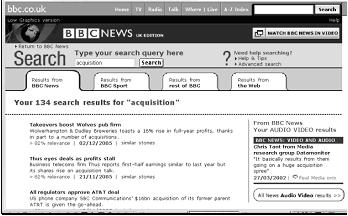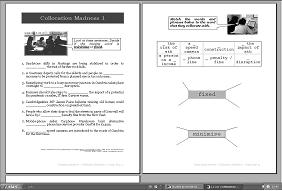Let's Collocate: Student Generated Worksheets as a Motivational Tool
Adam Simpson
Adam has been living and teaching English in Istanbul for the past seven years.
At present, he is heavily involved in the Sabanci University School of
Languages' vocabulary syllabus project. Adam encourages response to this article, and can be reached at adams@sabaciuniv.edu
Menu
Abstract
Background
Let's Collocate
Outcomes
Conclusion
Bibliography
This article discusses the process of producing collocation worksheets and the values of these worksheets as a motivational tool within a tertiary level preparatory English program. Firstly, the method by which these worksheets were produced is described, followed by an analysis of their effectiveness as a resource in terms of student motivation, personalisation, involvement in the development of the curriculum and in raising awareness of corpus linguistics and its applications.
Motivation is well documented as being a key element in language learning, with Dörnyei (2001:31) noting the importance of our role as the teacher in providing a stimulating classroom environment. Learner autonomy also plays an important part in student motivation because, as Nation (2001:394) notes, 'the more learners are aware of how learning is best carried out, the better the learning is likely to be. ' Students entering the context in which I teach, an English language preparatory program in the Turkish tertiary education system, generally exhibit certain traits when they first enter higher education. While certainly having external pressures placed on them, they may not in many cases be feeling high levels of intrinsic motivation. Indeed, the prospect of having to learn a second language to a level appropriate for academic study within strict time constraints often causes lack of confidence and avoidance, i.e. self-efficacy. Furthermore, such learners have almost always received little or no exposure to autonomous learning practices. Consequently, teachers in my position must take steps inside the classroom in order to foster motivation and develop autonomy, particularly in the area of vocabulary acquisition.
The vocabulary syllabus at my institution has been created along conventional lines: the general service list and the university list were combined to create a syllabus of approximately 3,000 headwords to be presented over the course of one academic year within the preparatory program. Students entering the program follow a course of academic English using the school's own coursebook series, and for each unit of each level a mini-dictionary has been compiled. The process of creating these mini-dictionaries drew upon freely available internet-based corpus analysis materials to analyse the contents of the books to choose appropriate items from the GSL and UWL to be presented and learnt for each particular unit. Additional worksheets were also produced to allow students to progress from first encountering these words to the point where they are able to use them productively in their writing and in discussion. The mini-dicitonaries and worksheets are used either in class and/or for self study, and form the basis for assessment.
While allowing for students to study independently and have, to a large degree, knowledge about what they needed to know - which lexical items and what it means to know these items - and some methods for developing this knowledge, the previously mentioned materials did not actively involve students in the curriculum or promote autonomous vocabulary acquisition. What was desired was material that would foster the three factors that Nation (2001:394) considers vital to autonomy: attitude, awareness, and capability. This will be discussed in more detail later.
Prior to engaging the students in the production of their worksheets a model was presented on a handout. The example presented to the students was for the word acquisition. Some questions were then given, starting with one relating to the general area of study: 'Is the word acquisition often used to talk about... art / business / history / philosophy? .'
Wolverhampton & Dudley Breweries toasts a 16% rise in full-year profits, thanks in part to a number of acquisitions.
Business telecoms firm thus reports first-half earnings similar to last year but its shares rise on acquisition talk.
US phone company SBC Communications' $16bn acquisition of its former parent AT&T is given the go-ahead.
Spanish telecoms giant Telefonica reports a surge in profit, boosted by acquisitions and income from operations in Latin America.
US bank profits get a lift from better stock, commodity and bond trading and a spate of mergers and acquisitions.
Pay-TV firm BSkyB is to raise £1bn through a bond issue and may use part of the proceeds to fund acquisitions.
Mobile phone giant Vodafone says it plans to expand through acquisitions in Asia Poland and France.
Belgian beer giant Inbev says half-year profits are up 86%, helped by last year's acquisition of Brazilian beer firm Ambev.
Zimbabwe's government tables a constitutional amendment bill to speed up the acquisitionof white-owned land.
US agrochemical giant Monsanto blames an 81% drop in third quarter profits on write-offs caused by two large-scale acquisitions.
|
With a degree of teacher assistance, the students were asked, and indeed were able to discover a lot of information about the lexis. Several of the examples mentioned the idea of 'increase': profits rising / being boosted /going up because of acquisitions. Also mentioned were expansion / large-scale acquisition. One sentence contained the strong collocation 'mergers and acquisitions', the two words being part of a semantic set. Another theme mentioned in a couple of sentences was that of 'permission', one example said that an acquisition was given the go-ahead, another talks of a government making a constitutional amendment. As Lewis (1993:120) notes, "it is not always straightforward to identify collocations because the words are not always immediately adjacent to each other". O'Dell (2005), in a recent article for this journal, reiterates, suggesting that, ''one of the major difficulties in finding frequent collocations by looking at three word clusters is the fact that the two parts of a collocation are often separate.'' Furthermore, Thornbury (1998) merely states, 'no noticing, no acquisition.' Consequently, it was interesting and pleasing to see how quickly students were able, even in a corpus as small as ten sentences, to recognise similarities and patterns associated with this particular lexical item.
These examples were taken from the BBC News website (retrieved 12/11/05) which would also serve as the source for the students to find their examples later. This resource illustrates how there are naturally occurring corpora readily available at our fingertips. Other news websites would undoubtedly offer similar types of results, and could be used just as effectively. These examples represent a series of news headlines which came as a result of entering 'acquisition' into the site's search facility. Students were explicitly shown the process on their handout with the following picture:

After answering the questions the students were required to select two vocabulary items from the coursebook unit list and follow the same process, working in pairs. By entering the words into the search facility, they were able to attain access to many full sentence examples of their lexical items, and choose examples that were suitable for worksheet adaptation, granted, with a substantial level of teacher guidance (less on subsequent tries). About five or six examples for each word were copied and pasted to a word document, at which point I would ask the students to highlight the collocates appearing in each of the sentences. This again required conscientious monitoring and assistance. The students then adapted the sentences into a gap-fill exercise and an accompanying spider diagram to reinforce the recording of the collocations. Before distributing the worksheets to their peers, the pairs were required to attend a tutorial in which they explained the work they had done. The below example illustrates a finished worksheet.

In order to further increase student ownership of the work, I took photos of the class while on task and got them to include these in the finished worksheet.
Earlier I noted that there were three elements regarded as essential in fostering autonomous learning: attitude, awareness, and capability. Firstly, this activity was useful in allowing the students to take some responsibility for their learning. By researching words and subsequently recording them in a way which they had not done previously, they were able to change at least in part their attitudes towards vocabulary learning. They were also able to increase their awareness of their approaches to learning. This became evident in our tutorials, as students showed signs of having reflected on the process undertaken. Finally, their capability to actively find and record collocations was enhanced.
Another point made earlier was that of the students' previous experiences of autonomous learning. Benson and Voller (1997:195) suggest five levels of implementation of autonomy, from awareness (of the pedagogical goals and content) through involvement, intervention, creation to transcendence (making links between the content of the classroom to the world beyond). This activity probably fits in to the intervention category: the students effectively modifying and adapting the goals and content of their learning program, if only in a very small way (for example, they had to choose words from the word list). The students not only seemed very comfortable with this, but were also pleased to find out that their finished products would be made available to their peers in other classes, and to classes in future years, i.e. that they had made something that would be used as a learning resource by others.
Secondary outcomes of the process were that the students learned to cite references and developed their ability to utilise internet search facilities.
The students were able to create a meaningful, durable learning resource in a highly motivating way. My involvement, albeit necessary, was restricted to guidance at the production stage, and as an aid to self reflection upon completion. Allowing students the opportunity to interact with the syllabus is vital if autonomy is to be achieved in a meaningful and motivating way. As Guthrie (2001) notes, choice is motivating; 'not only is providing choices a prominent practice among teachers, but studies of elementary school teachers' beliefs about motivation in general... reveal that they believe children need choice to develop independence.' This activity benefitted all parties; the students benefitted from being given a motivating task, which also served to foster their autonomous learning skills; the school's syllabus benefitted from the creation of new resources that could be exploited in the future; and I benefitted by being able to provide an opportunity to investigate the potential of the naturally occurring corpora that surround us these days.
Of course, examples taken from news websites are intended for native speakers, containing potential linguistic landmines for us to deal with. Consequently, such an activity is best suited to students at a high level of english, who would not be thrown by a high number of unknown words, and would be able to recognise near synonyms such as those we saw in the acquisition example. Also, I purposefully chose the BBC website for the type of language used, which is specific to the particular context of formally delivered news stories. This resource might not suit those whose needs are less academic.
It should be noted that such an activity requires good access to computers and the internet. My teaching context, in which all students have laptops, allows for this and therefore makes such work practicable on a day-to-day basis.
Benson, P. & Voller, P. (1997) Autonomy and Independence in Language Learning, Longman
Dörnyei, Z. (2001) Motivational Strategies in the Language Classroom, CUP
Guthrie, J.T. (2001). Contexts for Engagement and Motivation in Reading, Reading online. Retrieved August 21, 2006, from http://www.readingonline.org/articles/handbook/guthrie/index.html#menu
Lewis, M. (1993) The Lexical Approach, LTP
Nation, I.S.P. (2001) Learning Vocabulary in another Language, CUP
O'Dell, F. (2005) Using Corpora to Develop Materials on Collocation, Humanising Language Teaching, Year 7; Issue 5;
Thornbury, S. (1997) Reformulation and Reconstruction: Tasks that Promote Noticing, ELT Journal, Vol.51;

Please check the English for Teachers course at Pilgrims website.
Please check the Secondary Teaching course at Pilgrims website.
Please check the What's New in Language Teaching course at Pilgrims website.


|